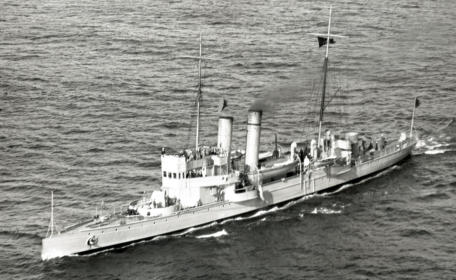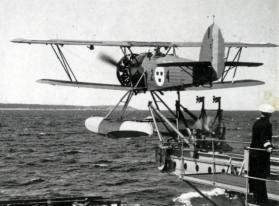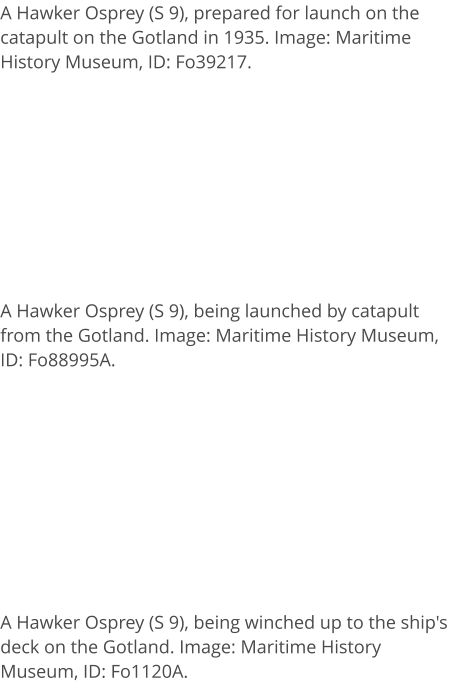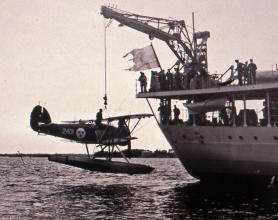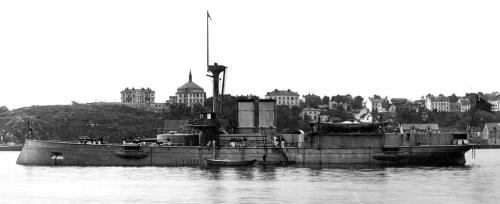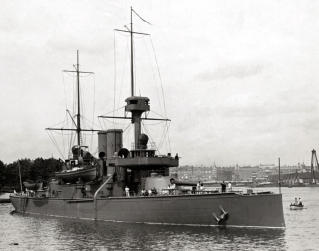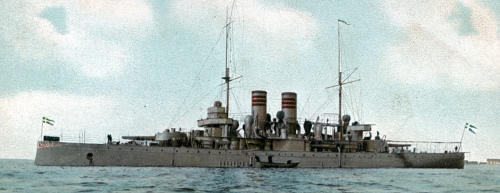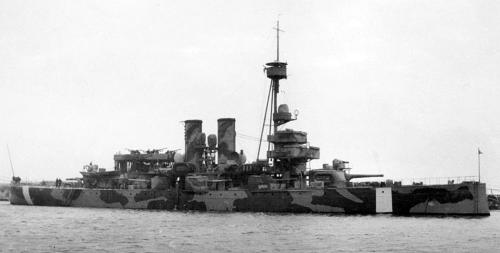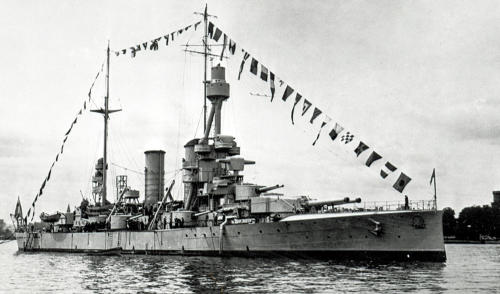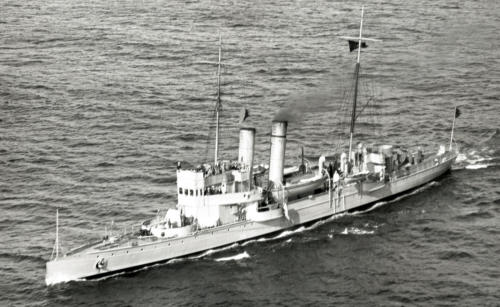

Copyright © Hans Högman 2023-10-02


Battleship (Swe: Slagskepp)
Battleships were the warships with the most
powerful naval artillery and the best armored of all
warships. Their heyday was between the 1850s and
the 1940s. The large armored battleships were
intended for the line of battle. They were designed
to fight against equivalent enemy warships with
direct or indirect fire from their main artillery. In
their secondary roles, they were capable of
bombarding targets on and near the coast to
support ground troops. However, with the advent
of aircraft carriers in World War II, battleships
became obsolete and have not played a prominent
role in any war since.
The Imperial Japanese Navy's battleship Satsuma,
launched in 1906, was the first ship to be designed
and built as an all-heavy armament battleship. HMS
Dreadnought was a British Royal Navy battleship
that revolutionized naval power when she entered
service in 1906. An example of a contemporary
American battleship is the USS Arkansas BB-33
(launched in 1911).
Several famous battleships were used during World
War II such as the German Bismarck (launched in
1939), the British Prince of Wales (launched in 1939),
and the Japanese battleship Yamato (launched in
1940). All three of these battleships were sunk in
battle during the war.
After World War II, several nations retained
battleships but they were generally considered
obsolete and outclassed by aircraft carriers.
Sweden has not had any battleships.
Coastal Defense Ship (Swe:
Pansarskepp)
In Sweden, until the 1920s, coastal defense ships
were known as 1st class armored boats and can
be described as warships with a displacement of
less than 10,000 tons, armed with heavy artillery
and roughly the size of an armored cruiser.
However, these armored ships/armored boats had
a limited blue-water capability. [A blue-water flotilla
is a maritime force capable of operating globally,
essentially across the deep waters of open oceans.]
Coastal defense ships were mainly used by the
navies of smaller countries, such as the Nordic
countries, the Netherlands, Greece, Portugal, etc.
Coastal defense ships are mainly used for coastal
defense and have therefore sometimes been called
coastal battleships, but coastal defense ships
should not be confused with battleships. The coastal
defense ships were a further development of the
monitors and armored gunboats.
Coastal defense ships were generally the main type
of ship in the respective countries' navies that used
this type of ship. Their construction and design
often resembled pre-dreadnought ships.
The main armament was usually distributed into
two gun turrets, one in the bow and one in the
stern. The ships' armament was often two and later
four heavy pieces of 20-28 cm (8-11 inch) caliber
and some lighter guns. Because of their shallow
draft, the ships were of great value in shallow
waters such as the archipelago and fjords.
Therefore, the ship type was particularly popular in
the Nordic navies and they were mainly used as
mobile coastal artillery forts.
The Sverige-class (Sweden-class) coastal defense
ships differed in several ways from the earlier
Swedish coastal defense ships, with heavier
armament and better speed and armor, but still
small enough to operate and hide in the
archipelagos and shallow waters (length 120 m/390
ft.). Unlike other coastal defense ships, the Sverige
class formed the core of a traditional open-sea
battle group (coastal fleet), operating with cruisers,
destroyers, torpedo boats, and aerial
reconnaissance in accordance with the traditional
battleship tactical doctrine of the time.
It has been suggested that the Sverige-Class coastal
defense ships were one reason why Germany did not
invade Sweden during World War II. Such speculation
appeared in Warship Magazine Annual 1992 in the
article "The Sverige-Class Coastal Defense Ships,"
by Daniel G. Harris. This has been partly confirmed
in post-war publications of German tactical orders
and scenarios for attacks on Sweden.
Swedish Coastal Defense Ships
Svea Class:
Sweden has had several smaller coastal defense
ships. Svea, (HM Armored Boat Svea) was the first
Swedish armored ship and the first to be built of
the three ships of the Svea class, which she formed
together with the coastal defense ships Göta and
Thule.
Svea was launched in 1885 and delivered to the
Navy in 1886, She was 75.7 meters long, had 6
cylinder-steam-boilers, and could make a speed of
15 knots. Svea's main armament consisted of two
25.4 cm guns m/1889 and a secondary armament
of four 15.2 cm guns. The displacement was 2,931 /
3,273 tons. Complement of 252 men (232 from
1904). Svea was decommissioned in 1941.
Göta (HM Armored Boat Göta) was launched in
1889 and delivered to the Navy in 1891. Thule (HM
Armored Boat Thule) was launched in 1893 and
delivered to the Navy in 1893. Göta and Thule were
slightly larger than Svea. Their length was 78.9 m.
Width: 14.8 m. The displacement was 3,097 tons
and the speed was 16 knots. Like Svea, Göta’s and
Thule’s main armament consisted of two 25.4 cm
guns and the secondary armament of four 15.2 cm
guns. Thule was decommissioned in 1923, Göta in
1938, and Svea in 1941.
The image shows the coastal defense ship Svea,
launched in 1885 and delivered in 1886. Length:
75.7 m. The photo was taken at the Stockholm
harbor entrance in June 1887. Image: Sjöhistoriska
museet, ID: Fo42305A.
The ships underwent several modernization during
their lifetime. Svea's most extensive modernization
took place in 1903-1904 when the heavy artillery
was replaced by a 21 cm piece in a single turret.
Oden klass:
The class consisted of three ships; Oden, Thor, and
Niord. The ships' main armament consisted of two
25.4 cm guns in two single turrets, one in the bow
and one in the stern, while the secondary
armament consisted of six (on Oden four) 12 cm
guns in casemates amidships.
Oden was launched in 1896 and delivered in 1897,
Thor was launched in 1898, and delivered in 1899
and Niord in 1898 respectively 1899. The ships were
84.8 meters long. Beam: 14.77 m. Displacement:
3,500/3,715 tonnes (Oden), 3,328/3,720 tonnes
(Thor and Niord). Propulsion: two 3-cylinder triple
expansion engines (5 530 ihp) with a maximum
speed of 16 knots. Complement: 239-254 men.
Between 1914 and 1917, the ships were brought to
the Karlskrona shipyard for remodeling. Oden was
the first to be modernized, followed by Thor and
finally Niord. New boilers were installed and the
flues were combined into a single, wider funnel.
Some changes were also made to the equipment.
Oden and Thor were decommissioned in 1937 and
Niord in 1944.
The image
shows the
coastal defense
ship Oden,
launched in
1896 and
delivered in
1897. Length:
84.8 m. Beam:
14.77 m. The
picture was
taken in 1897 at the time of the Stockholm
Exhibition. Image: Sjöhistoriska museet, ID:
Fo61482A.
Dristigheten class:
The class consisted of a single ship, Dristigheten
(officially HM Pansarbåt Dristigheten). Dristigheten
was a further development of the Oden class of
coastal defense ships and differed from that class
mainly by having more powerful secondary artillery.
The main armament originally consisted of two 21
cm guns and the secondary armament of eight 15.2
cm guns. She was launched in 1900 and delivered
to the Navy in 1901. Dristigheten was rebuilt as a
seaplane tender in 1927, after which the entire
armament was replaced and new equipment was
added. The ship was decommissioned in 1947.
It was 86.87 m in length and the beam was 14.78
m. Displacement: 3,200 / 3,600 tonnes.
Complement: 275-289 men.
The propulsion machinery consisted of steam
engines and 8 steam boilers. The steam from the
boilers was supplied to two three-cylinder triple
expansion steam engines with a total power of
5,400 ihp and a maximum speed of 16.8 knots.
The main innovation of these boilers was that they
were water tube boilers, unlike earlier coastal
defense ships which had fire tube boilers.
The image shows the coastal defense ship
Dristigheten, launched in 1900 and delivered in
1901. Length: 86.9 m. Beam: 14.8 m. Image:
Marinmuseum, ID: D 14989:14.
Äran class:
The 4 ships of the Äran class consisted of the
coastal defense ships Äran, Wasa, Tapperheten, and
Manligheten. The ships were delivered to the Navy
between 1902 and 1904. The design of the Äran
class was a development of the Dristigheten. Wasa
was decommissioned in 1940, at the beginning of
the Second World War, while the other three were
modified and used during the war.
Manligheten was the last ship to be
decommissioned, which happened in 1950.
Äran, Wasa, and Tapperheten were launched in
1901 while Manligheten was launched in 1903. Äran
and Wasa were delivered to the Navy in 1902,
Tapperheten in 1903, and Manligheten in 1904. Wasa
was decommissioned in 1940, Äran and
Tapperheten in 1947, and Manligheten in 1950.
The ship's main armament consisted of two 21 cm
m/98B guns in separate turrets located on the fore
and aft decks. The secondary artillery consisted of
six 15.2 cm m/98 guns. A major difference from
previous coastal defense ship classes was that the
guns were mounted in their own turrets, instead of
in casemates. There were also six 57 mm guns
m/89B.
The length was 87.5 m and the beam was 15 m.
Displacement: 3,650 / 3,735 tons. Propulsion: the
machinery consisted of two 3-cylinder triple-
expanding steam engines that received steam from
eight coal-fired boilers (5,500 ihp). Speed 16.5
knots. Complement: 285 men.
Between 1938 and 1941 the ships underwent
extensive modernization. These were not carried
out on Wasa as she was deemed to be too worn
out. The ships originally lacked artillery guidance
systems, which were now installed. Due to the rapid
development of the Air Force, anti-aircraft guns
were also installed. However, the three ships that
were modernized had slightly different
appearances during the upgrade. For example, Äran
received a new bridge for the anti-aircraft guns aft
of the smokestacks. Manligheten received the most
extensive modification, including a completely new
bow.
The image shows the coastal defense ship Äran,
launched in 1901 and delivered in 1902. Length:
87.5 m. Beam: 15 m. The ship has camouflage
painting and two white neutrality stripes on the hull
side. Photo in 1944. Image: Sjöhistoriska museet,
ID: Fo11368A.
Oscar II class:
The class consisted of a single ship, Oscar II
(officially HM Pansarbåt Oscar II). Oscar II was a
further development of the Äran-class coastal
defense ship but had an increased number of
medium guns in four double turrets, two on each
side. The number of steam boilers was increased to
10 distributed in three boiler rooms and had three
funnels (the only Swedish coastal defense ship with
three funnels). Oscar II was the last Swedish coastal
defense ship to be equipped with steam engines.
The machinery developed a total power of 9,400
hp.
The main armament consisted of two 21 cm guns
and the secondary armament of eight 15.2 cm
guns.
She was launched in 1905 and delivered to the
Navy in 1907. The ship was decommissioned in
1950.
Oscar II was 95.6 m long and the beam was 15.4 m.
Displacement: 4,273 / 4,495 tons. Complement: 326
men (335 as flagship). Speed 17.8 knots.
The ship underwent several modernization during
these years, the largest of which was carried out
before the Second World War. The main and
secondary artillery now had an increased range,
and fire control was improved by installing a central
sight in a new topmast and by taking over old fire
control instruments from HMS Sweden. She also
received new air defense. Furthermore, all ten
steam boilers were replaced with new ones, two of
which were equipped for oil firing.
The image shows the coastal defense ship Oscar II,
launched in 1903 and delivered in 1907. Length:
95.6 m. Beam: 15.4 m. Photo in 1940. Image:
Marinmuseum, ID: IV558.
Sverige Class:
Sverige Class (Sweden Class) was a class of coastal
defense ships consisting of three ships, Sverige,
Drottning Victoria, and Gustaf V.
HMS Sverige, also known as the F-boat, (eg. HM
Pansarskepp Sverige) was the first to be built in the
Sweden Class and was launched in 1915 and
delivered to the Navy in 1917. She was
decommissioned in 1947 and scrapped in 1953.
HMS Queen Victoria was launched in 1917 (delivered
in 1921). She was scrapped in 1957.
HMS Gustav V was launched in 1918 (delivered in
1922) and was the last ship in the class. She was
scrapped in 1957.
The Sweden-class ships were the largest and most
heavily armed coastal defense ships in the Swedish
Navy. HMS Sverige was financed by a national
fundraising campaign, while the other two were
financed by government funds.
The main armament consisted of two gun turrets
with twin 28 cm guns (one in the bow and one in
the stern) and the secondary armament of eight
15.2 cm guns.
The ships were 119.7 m long and the beam 18.6 m.
Displacement: 6,852 / 7,688 tons. Propulsion: Two
Kockums Curtis turbines (22,000 hp). Speed 22.5
knots. Complement: 427 men (443 men as
flagship).
During the interwar period, the ships underwent
several modernization, and at the outbreak of the
Second World War they were one of the most
powerful ships in the fleet. In 1924-1925, the ships
underwent their first major modernization. The
next major modification came in 1931-1933. In
1936 it was decided that Sweden's anti-aircraft
artillery would be strengthened and that the main
and secondary armament would be modernized. In
addition, oil firing was to be installed.
The image shows the coastal defense ship Sverige,
launched in 1915 and delivered in 1917. Length:
119.7 m. Beam: 18.6 m. Photo taken on the
Stockholm Stream. Image: Sjöhistoriska museet, ID:
Fo89011A.

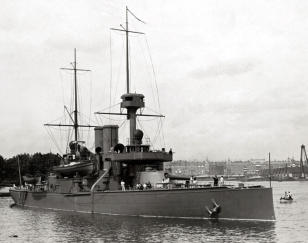
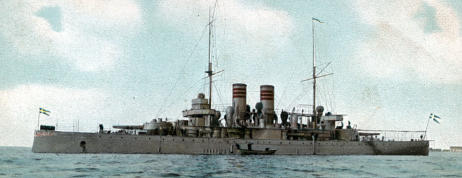


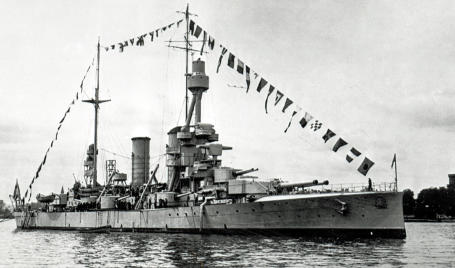
Ships of the Swedish Navy - 2
Swedish Warships - Surface
Combatants - 1
List of various types of Swedish Motorized
Surface Combatants
•
Battleship
•
Coastal defense ship
•
Cruiser, part-1, part-2
•
Destroyer, part-1, part-2, part-3
•
Frigate
•
Corvette
•
Motor torpedo boat
•
Torpedo boat / Missile boat
•
Patrol boat
•
Picket boat
•
Surveillance boat
•
Minelayer / Minehunter / Minesweeper
Definitions
In the description of the ships, there are some
concepts and terms that may be worth describing.
•
Pennant No., the recognition number that
Swedish warships normally, in peacetime, have
painted on the side of certain types of ships. For
submarines, it is an abbreviation of the
submarine's name.
•
Delivered refers to the time when the ship was
formally delivered to the Navy from the shipyard.
•
Launched, refers to the time when the ship was
christened and launched.
•
Decommissioned normally refers to the time
when the ship is permanently removed from the
Navy organization.
•
Displacement, expressed in tons, is given with two
values, standard displacement, and displacement
when the ship is fully equipped. If only one value is
given, it refers to standard displacement. For
submarines, displacement is given in surface
mode and submerged mode.
•
Speed is given in knots and refers to the
contracted speed. For submarines, the speed is
given in surface mode and submerged mode.
•
Dimensions, given in meters for length, beam,
and draft. The length may be given in two
dimensions: the waterline and the maximum
overall length. If only one length is given, the
maximum length is referred to. Beam means the
maximum width.
•
Complement, the crew size. It normally refers to
the peacetime crew size.
•
Submarine diving depths indicate the maximum
permitted diving depth in peacetime.
•
ihp = Indicated horsepower (the theoretical
power of a reciprocating engine if it is completely
frictionless)
The abbreviation "HMS" means “Hans Majestäts Skepp
/ Hennes Majestäts Skepp” and is used in the Swedish
Navy as a prefix before the ship's name, such as HMS
Visby. However, HMS was not used by the Swedish
Navy until after 1950. For older ships, i.e. built before
1950, "HM" (His Majesty's) was used followed by the
ship type and name, e.g. HM Kryssare Tre Kronor.
HSwMS is a sometimes used designation for military
ships from Sweden when traveling outside Sweden's
territorial waters, instead of HMS.
In the UK, the same abbreviation stands for Her
Majesty's Ship or His Majesty's Ship and has been used
in the Royal Navy since the 1660s. The USA uses the
designation USS, United States Ship.
During WW II, from June 23, 1940, Swedish warships
were marked with white transverse lines on their
decks and sides so that they could be clearly
identified as neutral ships and thus avoid accidental
fire from the belligerents.
Cruiser (Swe: Kryssare)
A cruiser is a large warship capable of engaging
multiple targets simultaneously. The cruiser is in the
size range between a battleship and a destroyer. The
main tasks of the cruiser included conducting
reconnaissance and surveillance at sea, destroying
the enemy's shipping, blocking, or otherwise
disturbing his coast, and protecting his own shipping
and coastline. In modern warfare, the cruiser has
almost completely disappeared, and its tasks have
been taken over by destroyers. The last Swedish
cruiser was HMS Göta Lejon, which was
decommissioned in 1970. The term “cruiser” is not a
term for a single type of ship. There are several
different types of warships that have been called
“cruisers”.
Some different types of cruisers:
•
Torpedo cruiser,
The torpedo cruiser was created as a separate type
at the end of the 19th century. They were equipped
with artillery and torpedoes to combat the then
new torpedo boats. Torpedo cruisers were
equipped with a thin armored deck.
•
Armored cruiser,
Cruisers generally had armored spaces for artillery
and turrets, as well as both side armor and
armored decks.
•
Protected cruiser,
The ships of this type had, apart from protection
for guns and ammunition storage, only one
armored deck.
•
Battlecruiser,
Battlecruisers were similar in size to battleships,
but this type of ship prioritized speed at the
expense of firepower and protection. Battlecruisers
were built to combat enemy armored cruisers and
for reconnaissance in front of the main fleet.
•
Light cruiser,
The warships classified as light cruisers usually had
a displacement of between 2,000 and 10,000 tons.
Artillery was usually 6-inch (152 mm) guns,
torpedoes, anti-aircraft guns, and sometimes their
own reconnaissance aircraft.
•
Anti-aircraft cruiser,
Anti-aircraft cruisers were a variant of light cruisers
and were often armed with medium artillery (which
could be elevated more than usual), torpedoes, and
anti-aircraft guns and were usually tasked with
protecting naval formations from air threats.
•
Heavy cruiser,
Heavy cruisers were armored and typically had a
displacement of between 10,000 and 30,000 tons
and the armament usually consisted of artillery up
to 8 inches (203 mm), as well as torpedoes. Often
the heavy cruisers were also equipped with their
own reconnaissance aircraft and catapult.
•
Seaplane cruiser,
A warship that combined many features of both
aircraft carriers and heavy cruisers. Typically, the
aircraft cruiser was equipped with relatively heavy
artillery, sea mines, and several floatplanes. The
Swedish HMS Gotland is an example of a seaplane
cruiser (seaplane tender).
•
Auxiliary cruiser,
During World War II, auxiliary cruisers were often
civilian ships commissioned and armed by the
navy. They were used for mine laying and as
convoy ships and were usually fast merchant ships
or ferries. Their armament usually consisted of
anti-aircraft and medium artillery (usually older
artillery pieces) but often lacked effective fire
control.
•
Guided-missile cruiser,
The guided-missile cruiser is a modern version of
the classic cruiser that replaced its heavy artillery
and anti-aircraft guns with various types of cruise,
anti-ship, and anti-aircraft missiles. They are the
only type of cruiser still in service today.
•
Mine cruiser,
The main task was to lay offensive mines.
Secondary tasks were reconnaissance and fire
support for own destroyers and torpedo boats and
fighting against enemy torpedo boats.
Swedish Cruisers
The first ships in the Swedish Navy to be called
cruisers were the 5 smaller ships of the Örnen class,
launched in the later years of the 19th century. They
were called torpedo cruisers.
Torpedo cruiser:
Örnen (officially HM Torpedkryssare Örnen) was the
first of a total of 5 torpedo cruisers in the Swedish
Navy. The class was called the Örnen class, which
consisted of the ships Örnen, Claes Horn, Jacob Bagge,
Psilander, and Clas Uggla.
The Eagle-class ships were 67.6 m long and the beam
was 8.2 m. The displacement was 800 tons. Speed: 19
knots. Complement: 104 men.
The Eagle was launched in 1896 and delivered to the
Navy in 1897 (decommissioned in 1947). Clas Horn
was launched in 1898 and delivered to the Navy in
1898 (decommissioned in 1923). Jacob Bagge was
launched in 1898 and delivered to the Navy in 1898
(decommissioned in 1947). Psilander was launched in
1899 and delivered to the Navy in 1900
(decommissioned in 1937). The Clas Uggla was
launched in 1899 and delivered to the Navy in 1900
(sunk in 1917 after being stranded on Storgrundet
near Ulvön south of Örnsköldsvik).
The main armament consisted of two 12 cm guns
m/94, the secondary armament of four 57 mm guns
m/89B. Furthermore, a 38 cm underwater torpedo
tube m/93.
The image shows the torpedo cruiser Örnen,
launched in 1896 and delivered in 1897. Length: 67.6
m. Beam: 8.2 m. Image: Marinmuseum, ID: IV1527.
Armored cruiser:
Fylgia (officially HM Pansarkryssare Fylgia) was the
only ship of the Fylgia class. She was launched at
Finnboda shipyard in 1905 and delivered to the Navy
in 1907. The ship was decommissioned in 1953.
The Fylgia was 115.1 m long, and the beam was 14.8
m. The displacement was 4,310/4,980 tons. Speed:
21.5 knots. Complement: 322 men. In addition to her
duties as an armored cruiser, she was also tasked
with conducting training expeditions with officer
cadets.
The main artillery consisted of eight 15.2 cm guns
m/03 in four twin turrets. These were in the bow, one
in the stern, and one on each side amidships. The
secondary artillery consisted of fourteen 57 mm
m/89B guns placed in five casemates on each side of
the hull and in two turrets on each of the forward and
aft bridges. In addition, there were two 37 mm m/98B
guns, and a torpedo room with two 45.7 cm m/04
underwater torpedoes in the forecastle.
The image shows the armored cruiser Fylgia,
launched in 1905 and delivered in 1907. Length: 115.1
m. Beam: 14.8 m. Photo: circa 1930. Image:
Marinmuseum, ID: IV121.
At the outbreak of World War II, Fylgia was
modernized and remained in service during the war.
All 57 mm pieces were removed and replaced by a
mixed anti-aircraft armament consisting of four 57
mm m/98B-38B guns, two double gyro-stabilized 40
mm m/36 automatic guns, a double 25 mm m/32
automatic gun, and a 20 mm automatic gun. The
main artillery was modernized and received new
ammunition. Furthermore, a new fire control with
central gun control was added. The two underwater
torpedo tubes were replaced by two swiveling 53 cm
tubes on either side of the deck.
The image shows Fylgia, after the modernization.
Launched in 1905 and delivered in 1907. Length:
115.1 m. Beam: 14.8 m. Marked with white neutrality
stripes. Photo: 1941, after renovation. Image:
Marinmuseum, ID: IV656.
Mine cruiser:
Clas Fleming (officially HM Minkryssare Clas Flemming)
was a mine cruiser built at Bergsund Engineering
Workshop, launched in 1912, and delivered to the
Navy in 1914. She was decommissioned in 1959.
The Clas Fleming was Sweden's first ship designed for
mine laying and was among the first Swedish
warships to use Parsons steam turbines. She was the
only ship of the Clas Flemming class.
She was 80.0 m long, and the beam was 10.4 m. The
displacement was 1,640/1,850 tons. Speed: 20 knots.
Complement: 160 men.
In the bow was a conning tower, from which fire
control and navigation were conducted, protected by
75 mm thick armor. As a mine cruiser, sea mines
were Clas Fleming's main armament. About 190
mines could be taken on board, of which 130 were
stored on deck and the rest down in the ship. In
addition, there were four 12 cm m/11 guns, two in the
bow, two in the stern, and four 6.5 mm m/10 machine
guns.
During World War I, it turned out that the mine ports
in the stern were too close to the water surface,
which meant that water could enter. After the war,
the stern was therefore rebuilt in 1918-1919 so that
the mine doors were raised, and the mine tracks were
covered by a deck. This also meant a change in the
position of the 12 cm guns. One gun was kept in the
bow and one in the stern, while the other two were
placed on either side just aft of amidship. The anti-
aircraft defense was improved in 1926 when the 6.5
mm machine guns were replaced by three 25 mm
automatic guns m/22.
Between November 1939 and August 1940, the ship
was modernized, including being extended by 6 m to
accommodate the new machinery, 4 six-cylinder two-
stroke diesel engines. The artillery was also
modernized, and the anti-aircraft defense was
reinforced with three 40 mm automatic guns m/36.
The aft mast was removed, and the forward mast was
shortened and modified, and the former smokestacks
were replaced by leaning backward, which
significantly changed the ship's silhouette.
The image shows the mine cruiser Clas Flemming,
launched in 1912 and delivered in 1914. Length: 80.0
m. Beam: 10.4 m. Photo after the modernization in
1939 / 1940 when, among other things, the aft mast
was removed. Image: Marinmuseum, ID:
DO14939:207.
Seaplane cruiser:
Gotland (officially HM Kryssare Gotland) was a
seaplane cruiser of the Swedish Navy. She was built
and launched at the Lindholmen shipyard in
Gothenburg in 1933 and delivered to the Navy in
1934. Gotland was the only seaplane cruiser in the
Swedish Navy. As a seaplane cruiser, she had a flight
deck on which 8 aircraft could be carried. On take-
off, the planes were launched by a pneumatically
operated catapult. When deployed, the catapult
formed a 22-meter-long runway on which the aircraft
was launched by compressed air at a speed of 100
km/h.
After reconnaissance missions, the pontoon-
equipped Hawker planes landed on the sea next to
the ship and were lifted on board the Gotland using a
crane at the stern.
The type of aircraft that could be carried was the
Hawker Osprey (S 9) reconnaissance plane, a biplane
with folding wings and slender floats mounted under
the fuselage. Although Gotland could carry 8 planes,
only 6 planes were acquired. The Hawker Osprey had
a two-man crew and was manned by Air Force
aviators.
The image shows the seaplane cruiser Gotland,
launched in 1933 and delivered in 1934. Length: 134.8
m. Beam: 15.4 m. Photo in 1943 before conversion to
an anti-aircraft cruiser. Image: Sjöhistoriska museet,
ID: Fo1120A.
At the outbreak of World War II, the ship was one of
the most modern in the Swedish naval fleet.
The Gotland spotted the German ships Bismarck and
Prinz Eugen in the Kattegat in 1941 on their way to
Norway, which was later passed on to the British
Navy, leading to the naval battles that ended with the
sinking of the Bismarck. By the winter of 1943/1944,
the rapid development of aviation had rendered
Gotland's biplanes obsolete. Therefore, the aircraft
equipment was scrapped and Gotland was converted
into a powerful anti-aircraft cruiser.
The image shows the seaplane cruiser Gotland,
launched in 1933 and delivered in 1934. Length: 134.8
m. Beam: 15.4 m. Photo after conversion to an anti-
aircraft cruiser 1943-1944. Image: Marinmuseum, ID:
B132:10.
She was 130.0 / 134.8 m long and the beam was 15.4
m. The displacement was 4,600/4,775 tons. Speed:
27.5 knots. Complement: 417 men.
She was powered by 4 oil-fired boilers that supplied
steam to two steam turbines, each driving a propeller.
The machinery produced 33,000 hp. Electricity was
generated in 4 generators. Two of these were driven
by diesel engines, and two by steam turbines.
The main artillery consisted of six 15.2 cm m/30
guns. Four of these were mounted in double turrets,
one on the foredeck and one aft of the funnels. The
remaining two were in separate casemates on either
side of the superstructure. The long-range anti-
aircraft defense consisted of four 75 mm anti-aircraft
guns in one double and two single gun carriages. The
close air defense consisted of four 25 mm automatic
guns m/32. The torpedo armament consisted of six
torpedoes in two rotating triple-tube racks, one on
each side of the aft deckhouse. Sea mines could also
be carried.
In 1943-1944, all aircraft equipment was removed and
replaced with anti-aircraft guns. On the flight deck, six
40 mm automatic guns were installed in three
machine-directed, gyro-stabilized double gun
carriages. An additional 40 mm automatic cannon
was mounted aft of these. After this conversion,
Gotland was used as a heavily armed anti-aircraft
cruiser for the rest of World War II.
She was decommissioned in 1960.
